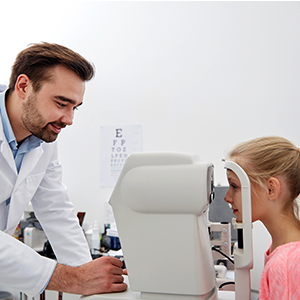Children with uncorrected vision conditions or eye health problems face
many obstacles in life – academically, socially and athletically. Children
often don’t know how they should see and may not know if something is
wrong. If a child’s eyes and vision suffer, so too will their general
health and ability to engage in normal childhood activities. Vision
problems have been shown to be associated with delayed development, poor
performance in school and social settings and low self-esteem. The sooner
eye problems are identified and addressed, the better the outcome in
childhood and beyond. High-quality eye care can help children reach their
highest potential.
The American Optometric Association’s (AOA) evidence-based guidelines for
comprehensive pediatric eye and vision examinations recommends that
children receive an annual comprehensive eye exam before first grade and
annually thereafter, and it informs optometrists which tests and
interventions are proven to optimize a child’s eye health and vision care.
Routine, standard screening tests are used to catch vision problems, but
sometimes these tests fail to catch a wide variety of other conditions that
only a comprehensive eye exam can catch.
The basic screenings are not enough – a comprehensive eye exam should be
one of the most important “to-dos” as children head back to school. Without
it, many children will suffer from undetected vision problems, which can
lead to learning difficulties – even to the point where a child is thought
to have a learning disorder, all because he or she has trouble seeing in
the classroom.
According to the AOA, as much as 80 percent of a child’s learning occurs
through his or her eyes. Reading, writing, using computers and playing
sports are among the visual activities children perform daily, so if a
child’s eyes are not functioning properly, education and participation in
sports can suffer.
Childhood myopia – difficulty seeing distant objects clearly – is on the
rise. Children spend an extensive amount of time on computers, cellphones
and electronic devices that are positioned
close to the face, which may lead to this condition. Also, less time spent
outdoors means less exercise for a child’s distance vision. When children
spend time outdoors, they exercise their long-distance vision, which may
help slow the “stretching” of the eyeball caused by looking at a screen
close up. This helps prevent not only severe myopia, but also
sight-threatening conditions as myopic retinopathy and retinal detachment.
Myopia correction measures should begin early in life because early-onset
myopia is associated with a more rapid progression and eventual development
of high myopia, which increases the risk of retinal detachment, cataracts,
glaucoma and other serious conditions.
Children who experience a concussion or eye injury should visit their
optometrist immediately for a comprehensive eye and vision exam. Children
are more vulnerable to the consequences of concussion and often have longer
recovery times and poorer outcomes than adults. One of the most common
problems for concussed children is that the child’s eyes do not work
together when trying to focus on a nearby object. Eye injuries can occur
from play, participation in sports, exposure to household chemicals,
accidents with tools or desk supplies, or careless use of tobacco,
fireworks, or BB or pellet guns.
Excessive exposure to sunlight (especially when reflected off snow) can
cause eye damage, particularly in infants and younger children, as can blue
light from cellphones, TV, video games and computer screens. Conditions
linked to childhood UV exposure include photokeratitis,
keratoconjunctivitis, retinal damage and squamous cell carcinoma of the
cornea and conjunctiva, as well as age-related conditions such as cataracts
and macular degeneration. Children should wear sunglasses and/or clear
prescription lenses that block at least 99 percent of UV light, not look
directly at the sun and have a comprehensive exam annually.
An annual comprehensive eye exam can not only catch eye problems early on,
but they can sometimes be a lifesaver. It proved to be so for an Atlanta
girl last year, who at the age of eight experienced excruciating headaches
that perplexed her physicians. When her mother took her to an optometrist
for her regular comprehensive eye exam, they discovered the cause of her
pain. The optometrist found a golf ball-sized tumor pressing on a nerve in
her brain. The non-cancerous tumor was removed and the girl has fully
recovered.
Children are at risk for a wide range of eye and vision disorders, but
annual comprehensive eye examinations conducted by a doctor of optometry
can improve detection, diagnosis and early
prevention or treatment of eye conditions. Addressing eye and vision
conditions early in a child’s life will have long-term positive
consequences in not only eye health, but also on educational attainment,
professional opportunities and quality of life.

